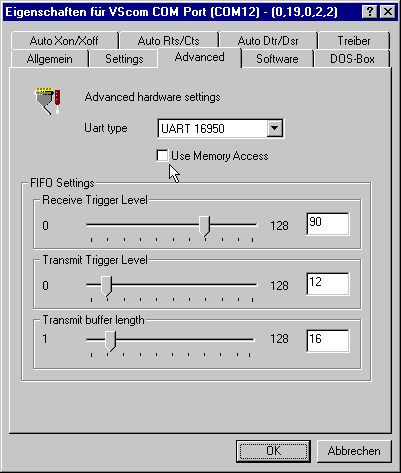
This panel is well known to most users. The only item important for some of the later panels is the "Flow control". "Hardware", "Software" and "None" are available values.
If you configure "Hardware", then you can configure special options in the RTS/CTS or DTR/DSR panels. If you select "Software", then you can configure special options in the Xon/Xoff panels. If you choose "None", neither panels are available.
To Contents
VScom Advanced port settings.

The VScom H-series uses a 16C950 UART to transmit data. This chip and the driver can emulate a variety of other UARTS. We suggest to use the standard value of 16950, the driver is optimized for this.
If the driver is used for other VScom series, a dfferent UART may be implemented. The available emulations depend on this. At least a 16550 is possible with all series.
The possible settings for FIFO control depend on the choosen emulation.
- UART type
- This is to choose the emulation. The UARTS of type 16450 and 8250 operate without FIFO. We suggest to use the highest possible setting for best operation.
- Use memory Access
- Instead of operating the UART via I/O, it is possible to operate it via Memory Access. In critical systems this can save a little amount of performance.
It may be worth a try, however we recommend to stay with the box unchecked. - Receive Trigger Level
- The time when the UART generates an interrupt for
received data. It defines the amount of data necessary to do this.
With the 16950 you may select any value from 1 to 128. Other types allow only certain values. Higher values increase performance, lower values decrease possibility for loss of data.
As a reference: the usual value for a 16550 is 8, leaving space for 8 more bytes to receive. - Transmit Trigger Level
- The time when the UART generates an interrupt for
sent data. When the transmit FIFO contains less data than this, the interrupt
is issued.
This value is not available with all emulations. Higher values smoothen the transmission of data, lower values increase system load. - Transmit Buffer Length
- The amount of data sent to the UART when the transmit
FIFO is empty.
This is a complete software item. The value ranges from 1 to the FIFO size of the emulation. Higher values increase transmission performance. But CAUTION: external hardware - such as a modem - must be able to handle this blocksize. The typical value here is 16, the FIFO size of a 16550. This value must not be less than the Transmit trigger level.
To Contents